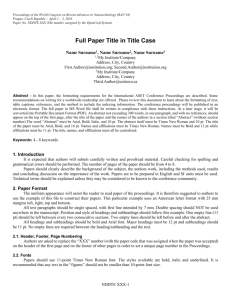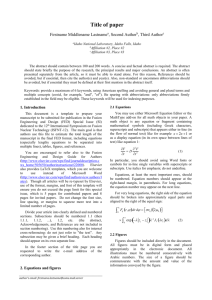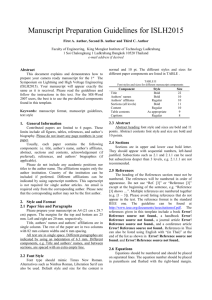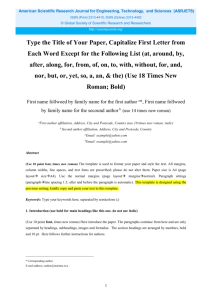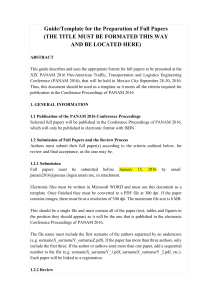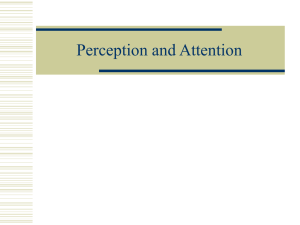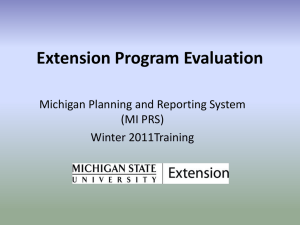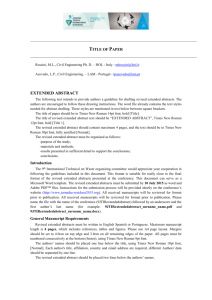template
advertisement
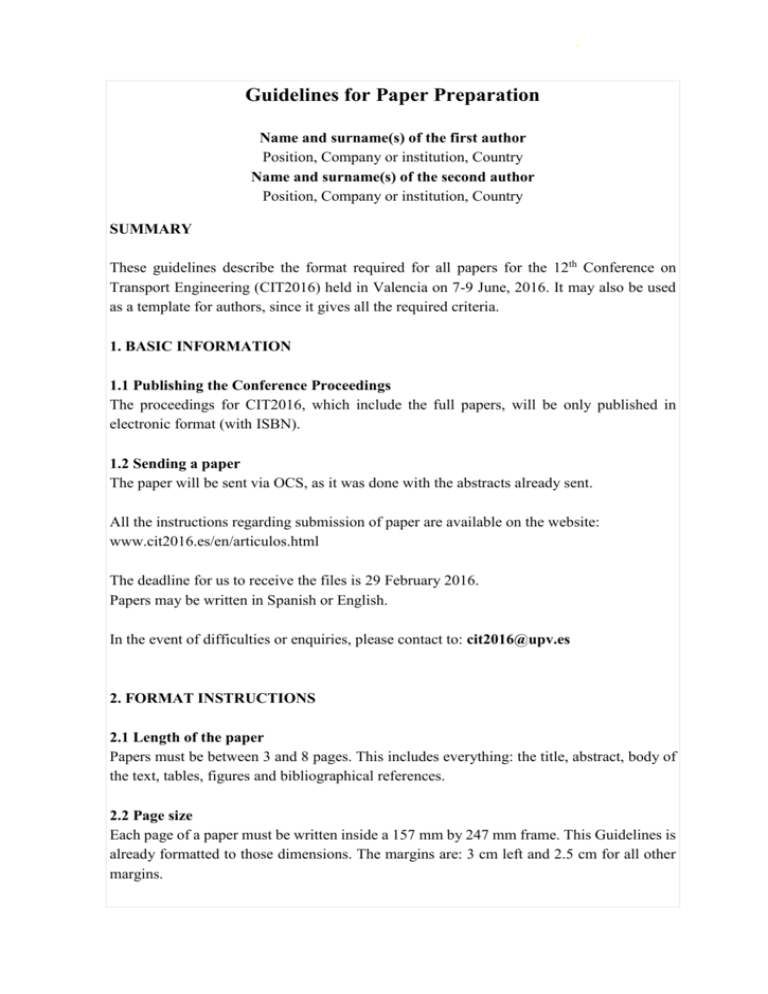
. Guidelines for Paper Preparation Name and surname(s) of the first author Position, Company or institution, Country Name and surname(s) of the second author Position, Company or institution, Country SUMMARY These guidelines describe the format required for all papers for the 12th Conference on Transport Engineering (CIT2016) held in Valencia on 7-9 June, 2016. It may also be used as a template for authors, since it gives all the required criteria. 1. BASIC INFORMATION 1.1 Publishing the Conference Proceedings The proceedings for CIT2016, which include the full papers, will be only published in electronic format (with ISBN). 1.2 Sending a paper The paper will be sent via OCS, as it was done with the abstracts already sent. All the instructions regarding submission of paper are available on the website: www.cit2016.es/en/articulos.html The deadline for us to receive the files is 29 February 2016. Papers may be written in Spanish or English. In the event of difficulties or enquiries, please contact to: cit2016@upv.es 2. FORMAT INSTRUCTIONS 2.1 Length of the paper Papers must be between 3 and 8 pages. This includes everything: the title, abstract, body of the text, tables, figures and bibliographical references. 2.2 Page size Each page of a paper must be written inside a 157 mm by 247 mm frame. This Guidelines is already formatted to those dimensions. The margins are: 3 cm left and 2.5 cm for all other margins. . 2.3 Font The font for the entire text is 12 point Times New Roman. The only exceptions are: (1) the paper's title, which is 16 point bold, and (2) the headings, titles of tables and titles of figures, whose basic size is 12 point, but in bold. Table 1 summarizes the specified fonts. Text element Font style Paper's title Times New Roman Headings Times New Roman Table titles Times New Roman Figure titles Times New Roman Text in paragraphs Times New Roman Tabla 1 – Summary of font specifications Font size 16 point 12 point 12 point 12 point 12 point Appearance Bold Bold Bold Bold Not bold The space between two lines throughout the paper must be 1.2; i.e. 120% of the font size used. 2.4 Punctuation Standard punctuation is used, always leaving a single space after each full stop, comma, colon and semi-colon. 2.5 Parts of the paper The main parts of a paper are the title and the list of authors, the abstract, the main text, the acknowledgements (optional) and the references. 2.5.1 Title and list of authors The title must be centered in the first line of the paper. Use 16 point bold. Write the name of the main author on the second line. Right the main author's affiliation and country on the third line. Write the names of the remaining authors on the following lines. Group together the names of the authors that share the same affiliation data. 2.5.2 Abstract Abstracts must be concise and clear, define the text and purpose of the paper, describe the methodology followed and set out the principal results and conclusions. It is best to avoid equations, abbreviations and references to sentences, figures, tables and illustrations in the body of the paper or in other documents. The size of the abstract must allow it to be read right on the first page of the paper. This abstract does not necessarily need to coincide with the abstract enclosed as the document to be printed in the Abstracts Book handed out during the conference. . 2.5.3 Main text The paper's main text needs to be organized into logical sections, with sufficiently descriptive headings. Figure 1 gives the criteria for numbering and the style of headings for the various sections. 5. FIRST LEVEL HEADING 5.1 Second level heading 5.1.1 Third level heading Fig. 1 – Numbering and style for headings All the paragraphs must be justified. Make the lines of a paragraph single spaced, and the lines between two paragraphs double spaced. Begin all paragraphs with no tabulation, so they will start at the left margin. Start the first paragraph of all first level sections with a single space in relation to the title or heading for that section. 2.5.4 Acknowledgements Acknowledgements are optional. Authors use this section to acknowledge the support received in the course of the study or research, or any other contribution to their work. Use the acknowledgement section after the paper's main text, as these Guidelines template shows. 2.5.5 References Use the reference section at the end of these Guidelines as a template. 2.6 Tables Integrate the tables into the text, in their proper position and numbered consecutively by order of appearance. Always write the titles of tables under the table, justified to the left, with the left margin, and in bold, as the example of Table 1 shows. Leave one line of space between the preceding text and the table, and between the table's title and the text immediately below it. 2.7 Figures Figures may be diagrams, photographs, charts or any other illustrative material. In the electronic file, they must occupy the precise place where they are to appear in the published paper. Number the figures by the order in which they are referred to in the text. The same criteria described for the tables applies to the figures, as Figure 1 shows. Likewise, leave a space before and after the figures with regard to the main text. 2.8 Equations . Centre equations with their order indicator aligned to the right, as Equation (1) shows. V x1 x2 Y (1) Subscripts and superscripts must be clearly positioned and the mathematical symbols properly aligned. Make sure to make a clear distinction between upper case and lower case letters. Leave a blank space above and below the equations. 2.9 Metric units Use only metric units. Certain criteria to take into consideration are: Unit symbols do not change in the plural: 3 km, not 3 kms. Leave a space between a number and its symbol: 4 m, 4 g. Only use symbols when the units accompany a number (2 mm). Otherwise, write the full word (the measurements were taken in milimetres). Time units or angular units are h, min and s. Unit symbols are not followed by a dot, unless they are at the end of a sentence. 2.10 Footnotes Do not use footnotes, except for the marks in tables, which are placed below the tables and are referred to with one or more asterisks: *. 2.11 Citations To cite a paper published by another author, you may add the citation between quotation marks as a continuation of the text, providing it is no longer than 20 words. Otherwise, it is best to put it in a separate paragraph, below the text, between quotation marks and indented 10 mm from the left margin. An example would be: “xxx xxxxxxxx xxxxxx xxxxxxxxxxxxxx xxx xxxxxx xx xxxxx xxx xxx xxxx xxxxxxxx xxxxxx xxx xxx xx xxxxxx xxxx xxx xxxxxxx xxx xxx xx xxx xx xxxx xxxx xxxx” 2.12 Appendices Do not use appendices. Include the full content directly in the paper or cite other publications that serve as support or give further details in the final list of references. ACKNOLEDGEMENTS These Guidelines is based on the “Guidelines for Paper Preparation” for the 2nd International Symposium on Highway Geometric Design, organized by the Transportation Research Board (TRB) and Forschungsgesellschaft fur Strassen-und Verkehrswesen (FGSV), held on 14-16 June 2000 in Mainz, Germany. . REFERENCES References in a paper's text give the author's first surname and the year the work was published. Some examples are: For one author: “Adams (1948) developed a technique for...” or “... as previously established (Brown, 1987).” For two authors: “Charles and Davis (1978) recommended…” or “... as previously developed (Charles and Davis, 1978).” To cite one of the works of a single author published in the same year: (Evans, 1985a) or Evans (1985a). For one or more references cited together: (Ford, 1987; George, 1986) or Ford (1987), and George (1986). Place all the references cited in the text at the end of your paper. It is important for the list to be very complete, accurate and detailed so anyone interested may find each individual source cited. The list of references should include only the references cited in the text. List the references in alphabetical order by the authors' first surname and in descending chronological order for each author. The surname is written first in upper case, followed by the name and then the year published between parentheses. When you add the letters a, b, c, etc. to make a distinction between works by a single author published in the same year, include them in the list of references in the same order in which they are cited in the text. For instance, do not read the text on Smith (1976b) before Smith (1976a). When an author has several references as a single author and as a co-author, place the single works before the joint works, although all the works are listed as written by the same author. List co-authored works by alphabetical order of the second author's name. Please use the style given below as reference for different types of work: Book HOYLE, B.S. and KNOWLES, R.D. (1992). Modern Geography. Belhaven Press, London. Magazine article SOLOMON, K.T. (1978). Sand in concrete mixes. Australian Road Research 7(3), pp. 2730. A chapter by one author in a book published by other authors . EULER, G.W. (1992). Intelligent vehicle-highway systems. In: J.L. PLINE (ed.) Traffic Engineering Handbook, 4th edition. Prentice Hall, Englewood Cliffs, N.J. pp. 448-463. Conference paper O’BRIEN, A. (1992). Safety audit for rural intersections. Workshop on Road Safety Audit, 14-16 April 1993, ponencia 6. Monash Transport Group, Clayton, Victoria. Series DEMPSEY, B. Climatic Effects of Airport Pavement Systems: State of the Art. Report DOT-RD-75-196. FHWA. U.S. Department of Transportation, 1976.

